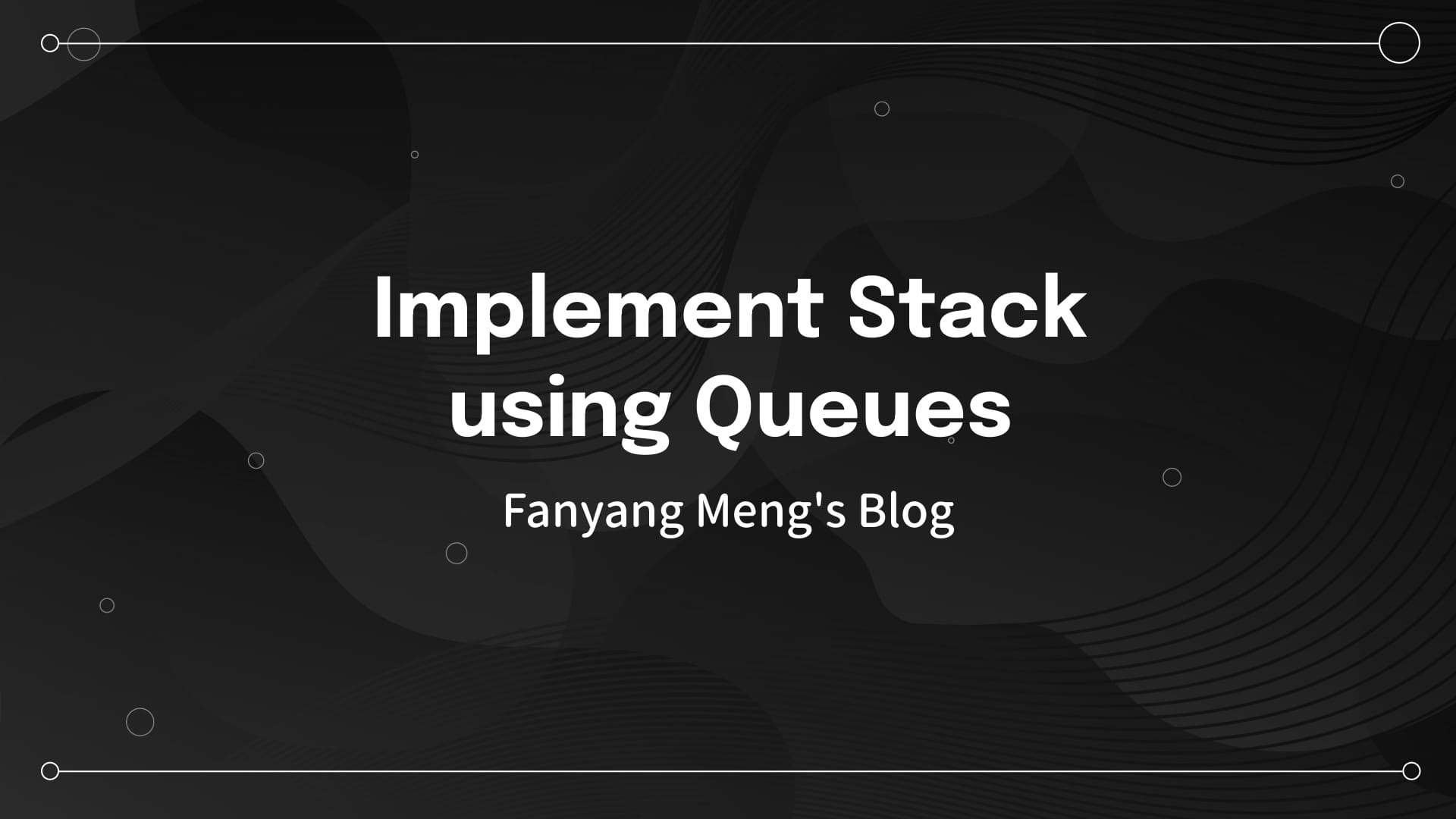LeetCode Link: 225. Implement Stack using Queues
Problem Definition
Implement a last-in-first-out (LIFO) stack using only two queues. The implemented stack should support all the functions of a normal stack (push, top, pop, and empty).
Implement the MyStack class:
void push(int x)Pushes element x to the top of the stack.int pop()Removes the element on the top of the stack and returns it.int top()Returns the element on the top of the stack.boolean empty()Returnstrueif the stack is empty,falseotherwise.
Notes:
- You must use only standard operations of a queue, which means that only
push to back,peek/pop from front,sizeandis emptyoperations are valid. - Depending on your language, the queue may not be supported natively. You may simulate a queue using a list or deque (double-ended queue) as long as you use only a queue's standard operations.
Example 1:
Input
["MyStack", "push", "push", "top", "pop", "empty"]
[[], [1], [2], [], [], []]Output
[null, null, null, 2, 2, false]Explanation
Input
["MyStack", "push", "push", "top", "pop", "empty"]
[[], [1], [2], [], [], []]
Output
[null, null, null, 2, 2, false]
Explanation
MyStack myStack = new MyStack();
myStack.push(1);
myStack.push(2);
myStack.top(); // return 2
myStack.pop(); // return 2
myStack.empty(); // return FalseConstraints:
1 <= x <= 9- At most
100calls will be made topush,pop,top, andempty. - All the calls to
popandtopare valid.
Approach
This problem is more about understanding the properties of stacks and queues rather than its direct application. Here, we need to reverse the first-in-first-out (FIFO) nature of a queue to mimic the last-in-first-out (LIFO) behavior of a stack.
Using Two Queues
We can use two queues to implement a stack. The idea is as follows:
- Use one queue (
queue1) as the main storage for elements. - Use another queue (
queue2) as a temporary backup. - When performing a
poportopoperation, transfer all elements fromqueue1toqueue2except the last one. This ensures the last element inqueue1mimics the top of the stack. - Swap
queue1andqueue2to maintain the stack behavior.
This method has a time complexity of O(n) for pop and top operations.
Optimized Solution: Single Queue
Using a single queue, we can simulate stack behavior by rotating the elements within the queue itself:
- During the
pushoperation, enqueue the element normally. - Rotate the queue so that the newly added element comes to the front, maintaining the stack's LIFO order.
- For
popandtop, the front element of the queue will directly represent the top of the stack.
This method reduces space usage and simplifies implementation.
Solution 1 - Using Two Queues
from collections import deque
class MyStack:
def __init__(self):
self.queue1 = deque()
self.queue2 = deque()
def push(self, x: int) -> None:
self.queue1.append(x)
def pop(self) -> int:
while len(self.queue1) > 1:
self.queue2.append(self.queue1.popleft())
result = self.queue1.popleft()
self.queue1, self.queue2 = self.queue2, self.queue1
return result
def top(self) -> int:
while len(self.queue1) > 1:
self.queue2.append(self.queue1.popleft())
result = self.queue1.popleft()
self.queue2.append(result)
self.queue1, self.queue2 = self.queue2, self.queue1
return result
def empty(self) -> bool:
return not self.queue1Solution 2 - Using a Single Queue (Optimized)
class MyStack:
def __init__(self):
self.queue = deque()
def push(self, x: int) -> None:
self.queue.append(x)
for _ in range(len(self.queue) - 1):
self.queue.append(self.queue.popleft())
def pop(self) -> int:
return self.queue.popleft() if not self.empty() else None
def top(self) -> int:
return self.queue[0] if not self.empty() else None
def empty(self) -> bool:
return not self.queueComplexity Analysis
Two-Queue Solution
- Time Complexity:
push: O(1)popandtop: O(n) (due to transferring elements between queues)
- Space Complexity: O(n) (for two queues)
Single-Queue Solution (Optimized)
- Time Complexity:
push: O(n) (due to reordering elements after each push)popandtop: O(1)
- Space Complexity: O(n) (for the single queue)
Conclusion
The single-queue approach is more space-efficient and has a simpler implementation compared to the two-queue approach. However, it comes with the trade-off of increased time complexity for the push operation. Understanding both approaches is valuable as they demonstrate different problem-solving techniques for simulating one data structure using another.

Discussion